|
Of all the observations on the nature of life I have come across from the popular comic strip Peanuts by Charles Schulz, there is one which I have been touched by the most. In a recurring plot, the main character, a fellow named Charlie Brown, falls for a beautiful peer of his known only as “The Little Red-Haired Girl.” Just being in the same room as her makes poor ole Charlie Brown tremble as he is enamored by her incredible beauty, talent, and personality… three characteristics he cannot possibly boast of his own. One day, he finds a pencil of hers and, to his astonishment, finds that it is covered in her teeth marks. This odd observation immediately causes Charlie Brown to find new confidence to pursue her and make her notice him, triumphantly exclaiming, “She’s human!” Especially as we approach Christmas, this simple yet amazing truth reflects upon one of the cornerstones of our Faith: “the Word became flesh and dwelt among us” (Jn 1:14). How much more relatable is a God Who became human! Yet often we may forget this in light of His divinity, instead placing God on a high pedestal for us to approach and gaze upon but never quite reach. We may discourage ourselves with this thinking of authentic Christian living as merely lofty ideals and unreachable standards— “speech and day dreams” according to St. Vincent Pallotti. The question, then, “What is God really like?” is answered during an exchange between Jesus and His disciple Philip: “Lord, show us the Father and that will be enough for us,” (Jn 14:8) Philip asks, to which Jesus responds, “He who has seen me has seen the Father” (Jn 14:9). Not only do the emotions of Jesus reflect a necessary component of the image and likeness of God that each of us is made in, His emotions also reveal the nature of God. Believing that the written Word and the Living Word give us a trustworthy revelation of God, we know that God is in fact emotional. Jesus felt “compassion,” “pitied,” and was “deeply moved;” he was “angry,” “indignant,” and “consumed with zeal;” he was “troubled,” “greatly distressed,” “very sorrowful,” and “grieved;” he “sighed,” “wept,” “groaned,” and was “in agony;” he was “amazed;” he “rejoiced very greatly,” and was “full of joy;” he “greatly desired” and he “loved.” In our quest to be like Jesus, however, we often overlook his emotions. Jesus reveals what it means to be fully human and made in the image of God. His emotions reflect that Identity without any deficiency or distortion. When we compare our own emotional lives to His, we become aware of our need for a transformation of our emotions so that we can be fully human, as He is. Christmas reminds us of the incredible, baffling mystery of the Incarnation—God, the Creator of the universe humbled Himself by taking on human form! From the time Christ lay upon the wood of the manger through His expiration on the wood of the Cross, we see and are able to relate to not just the idealization of humanity, but how to endure life’s pains, sorrows, and tribulations, as well as its joys and triumphs. If we are the body of Christ, created and redeemed to represent Jesus in the world, then we, like St. Paul, need to “gaze upon him” and learn to reflect the emotions of Jesus (Hebrews 12:2). Then we can know Him, and in knowing Him know God, and know ourselves as we were created to be. May God bless you, and God love you! Have a blessed Advent and Christmas! For more resources to prepare you for Christmas, please click here. This resource and more resources for Christmas and Advent can be found here.
0 Comments
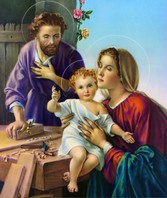 Christmas is on Friday. Wait, really?! Have we bought all of our presents? Are we ready for a Christmas feast? Is work ever going to end? These are the thoughts that plague us right now, but what we really should be asking is: are we ready for the birth of Christ? Advent is almost over - was there really enough time to prepare for the birth of the Son of God? The short is answer is 'no,' and the long answer is still 'no.’ But we know that as we prepare each liturgical year we take another step on the long journey toward Christ. Each celebration gives us the chance to refocus on that journey and draws us back into living out our faith wholly and fully. Who better to help us refocus our sight on Christ than the Holy Family? The Holy Family is the PERFECT example for us as we share in similar struggles. Through the Incarnation, Jesus became man and we believe him to be both fully human and fully divine. In a beautiful way his humanity is formed by Mary and Joseph. Who better to relate to then Mary and Joseph themselves? They were there when they thought Jesus was lost in the temple and there throughout his adolescence. Mary was there to inspire him to begin his ministry at Cana and was there as her son gave up his life for us. During Advent and Christmas we are watching Mary, Joseph, and Jesus grow and become a family. We should take this opportunity to allow ourselves to walk in their footsteps and live a life wholly committed to Christ. We should take this opportunity to ask for their intercession and assistance on our journey to God. Please do not think that their example only applies to families! Their example applies to each and every Catholic, Christian, non-Christian, and human being. The virtues that they live in the Bible are virtues that we should all be living. Look to how Mary and Joseph interact and form Jesus and open yourself up to them. No matter where we are in life we can learn from their unwavering commitment and their steadfast love. I challenge you to think about someone in your life who embodies these qualities: “unwavering commitment” and “steadfast love.” I only have to think back to last week at my father-in-law’s funeral. My wife was delivering the eulogy and said, “[he] reminded me of the importance of the ‘virtue of selfishness,’ as he so called it. This means that you can take control of how you feel, and you must take care of yourself so that you can take care of others. If you have nothing to give, what then are you authentically giving?” He got it. He understood that God is calling us to form ourselves in our faith, to root ourselves in him because we cannot lead others to God without first opening ourselves to his grace. How do we do this? We commit ourselves to Christ with steadfast love. This Advent, as we are preparing for the birth of Christ, let us remember to ground ourselves in his love so that as the new year comes we can go out and evangelize the world. Let us also remember Saint Pope John Paul II’s words on the Holy Family: “I wish to invoke the protection of the Holy Family of Nazareth…it is therefore the prototype and example for all Christian families…St. Joseph was a “just man”…may he always guard, protect and enlighten families. May the Virgin Mary, who is the Mother of the Church, also be the Mother of “the Church of the home”…May Christ the Lord, the Universal King, the King of Families, be present in every Christian home as He was at Cana, bestowing light, joy, serenity, and strength”. Nicholas Shields is a young professional working in Washington, DC.
This past Sunday, we celebrated the First Sunday of Advent, the time of preparation for the coming of Christ. This Advent season also signals the beginning of the liturgical New Year. Now, I’m the kind of girl that has been secretly listening to Christmas Carols since mid-November (with headphones and lowered volume so no one knows my secret!) so Advent is one of my favorite times of year. As a little girl, I loved the buildup to Christmas and loved helping my mom prepare our house for the torrent of annual Christmas events. From decorating the tree to baking cookies, I loved it all.
When we were little, my mom modeled an activity we did in school, placing an empty manger on our mantle with a bowl of straw. She explained to my brother, sisters, and me that Advent was about preparing for Christ’s birth and we had to prepare a comfortable crib for him by filling the manger with pieces of straw. She encouraged us to do kind things for those we knew and when we did to place a piece of straw in the manger. Throughout Advent we delighted in finding ways we could add more to the manger. The one rule that she had was that we could only place straw in the manger quietly, without bragging of our good deeds to each other, and we had to decide personally what qualified to place straw in the manger. The straw grew and grew and by Christmas the manger was full, ready for Christ. Although this activity seems small in the hustle and bustle of the Advent season, it taught my siblings and me a lot about what the season was really about. Even as children, my mom strove to make sure that while we could get involved and excited about preparing for Christmas, we had to understand the true meaning behind the season. Advent, she always explained, was about preparing for the coming of Christ and not simply getting excited for Santa to visit. While we celebrate Advent and Christmas in many different ways, the important thing to remember is just how miraculous the Incarnation truly is. The miracle of the Incarnation is that Christ was made known to us in human form, to ultimately sacrifice Himself for us. While this time of the year has many stresses as we try to prepare for all that is expected of us, keeping the “true meaning of Christmas” in mind throughout Advent is a good habit to get into. As you begin this Advent season, I encourage you to take some time to remember what we are preparing for. The selfless love that Christ demonstrates is what we celebrate this Advent season. Take a moment to step back and reflect on how you can prepare yourself for His coming. Rebecca Ruesch is the Blog Editor for the Catholic Apostolate Center For more information, check out the Catholic Apostolate Center's Advent Resource Page! As the Church and world celebrate the canonization of St. John XXIII and St. John Paul II today, it is important to note the significance of this day on which these canonizations are taking place, Divine Mercy Sunday. For St. John Paul II, the Mercy of God was an early and prevalent theme in his pontificate. In 1980, he issued the encyclical, Dives in Miseracordia, which not only views Jesus Christ as the “Incarnation of mercy” (2), but also teaches that mercy is “the fundamental content of the messianic message of Christ and the constitutive power of His mission” (6). The ramification of such a bold way of describing mercy challenges human beings to move beyond a basic understanding of justice. He notes that “mercy has the power to confer on justice a new content, which is expressed most simply and fully in forgiveness” (14).
Forgiveness in an age of self-centeredness and rabid individualism is often seen as weakness. And yet, through the seeming weakness of the Cross, his “sorrowful passion,” forgiveness, love, and mercy are offered “to us and to the whole world” (Cf. Chaplet of Divine Mercy). They are confirmed in the Resurrection of Jesus Christ who appears to his disciples and takes away all doubt, bringing peace to those in fear. All of the baptized are called to carry on this mission of Christ that offers mercy to a suffering and broken world. A life lived in mercy will lead to greater unity with one another. St. John Paul II when he canonized the visionary of Divine Mercy, St. Faustina Kowolska, and declared the Second Sunday of Easter, “Divine Mercy Sunday,” in the Jubilee Year of 2000, said in his homily that day, that Jesus “showed us the many paths of mercy, which not only forgives sins but reaches out to all human needs…every kind of human poverty, material and spiritual” (Homily for Divine Mercy Sunday, 4). True and lasting forgiveness that leads to living a life of deeper compassion and mercy can only occur with trust. The Apostle Thomas in today’s Gospel passage did not trust the word of witness of his brothers and sisters in the Upper Room. He needed to experience the mercy of Jesus Christ for himself, as do we. It is only through a personal encounter with Christ as the Merciful One that we have the graced strength to say, “Jesus, I trust in You!” Fr. Frank Donio, S.A.C., D.Min. is Director of the Catholic Apostolate Center. Click here for Canonization resources and a webinar on the new pope saints. This blog post was first published earlier today on the St. Joseph’s College of Maine Theology Faculty Blog. Fr. Frank is an adjunct professor on both the undergraduate and graduate Theology faculties. Click here to learn more about our cooperative alliance with St. Joseph’s College Online. This past Tuesday, the Church celebrated the Solemnity of the Annunciation of the Lord. This feast, which commemorates the moment Gabriel appeared to the Virgin Mary to announce the plan of salvation God intended to bring forth, can seem a bit odd to celebrate during Lent. The Annunciation is a moment that we would usually associate with Christmas, as it introduces us to the official incarnation of God as Man. While March 25th is exactly 9 months before December 25th, I believe that celebrating the Annunciation during this time has more meaning than simply the significance of 9 months to December. In this post, I hope to share with you my thoughts on a few of the many beautiful features of this event in Christianity and how it pertains to our mission in the Liturgical season of Lent.
The Annunciation emphasizes both the importance of Mary and how the Annunciation brings the Incarnation of God into the realm of human history. I have noticed that people, when discussing this crucial event, typically compartmentalize these two aspects while forgetting their interconnectivity. I also find that this can result in one compartmentalizing their relationship with Mary and their relationship with God, failing to recognize how the two are woven together. I say this because I am certainly guilty as charged! Seeing the beautiful harmonization of the New Adam (Jesus) and the New Eve (Mary) can help us better understand the correct approach to bringing our hearts closer to God during Lent. You might then ask how this interconnectivity between Mary and the Incarnation occurs. Yes, Mary did give birth to Jesus, and many people stop there. However, I believe the harmonization is more than the mere act of Mary giving birth. This is where the Annunciation comes into play, as Mary agreed to submit herself fully to God’s will. The nature in which such agreement is founded on remains an open question. With this, however, I have found that the best answer to this question (in the span of my short, and continuously developing spiritual journey) lies in the spirituality that is the source and foundation of the Catholic Apostolate Center. In a blog I wrote some while back, I talked about God as Infinite Love, and I reference this again because I am referring to a spirituality of collaboration, where the Love of God is a collaborative invitation to participate in His will, which subsequently leads to being one with His love. We walk on our journey together with God, and this connectedness is why such a harmonization between the role of Mary and the Incarnation of Christ exists. The answer to how this harmony exists lies in the gift of free will. I mention free will because of it is important in the understanding of a collaborative relationship with God, one where we are free rather than forced to conform to His will. Another way of saying this is that God could have entered humanity, without our consent, into a new order where the original graces and gifts would be restored. However, God wanted us to love Him, and such love requires an act to freely choose Him while simultaneously rejecting something else (i.e. sin, worldly pleasures, and so forth). If God were to redeem humanity through the Incarnation of Christ, it would then be by human consent, in order that our dignity is maintained and we are ably to participate in this Infinite Love of God, and that God would offer the Incarnation (and therefore the opportunity to regain access to full participation in such Love) by means of collaboration with humanity. It is only through such collaboration that participation in the Love of God can occur. This is where our Blessed Mother, Mary, enters into the conversation. In the Annunciation, Mary is asked by the Angel Gabriel if she would freely consent to God’s plan to take humanity out of the abyss and to let him be completely enraptured by God’s Love (See Luke 1:26-35). Her response was the greatest act of liberty the world has ever seen: “Be it done unto me according to thy word” (Luke 1:38). This freedom is perfect because her Son was willed, and not merely accepted in any unforeseen or unpredictable way. There was no element of chance, but a desire of the Father to enact His will of salvation by means of collaboration. Mary, having full faith and love for God, essentially said “yes, I am willing to collaborate with Your will in order that I may participate in your Love.” Her willingness to collaborate is an act of harmonization, one that we cannot ignore in our lives of prayer and charity. With this being noted, how does this pertain to our journey of faith during the Lenten Season? Like Mary, we are called by God to collaborate with His will in order that we may grow in holiness and be ravished by His Love. The Annunciation reminds us that we have this gift of freedom to participate in such collaboration. After all, it would not be collaboration if we were forced to participate! We are shown that we can choose God and reject the things that keep us away from Him. This choice is deeply rooted to the extent that God would offer such a choice pertaining to our very own salvation, the Incarnation of His very own Son. Fortunately, we have an example, a role model who perfected this very act of freedom. That role model is Mary, as she collaborated with God’s will. Because of such a harmonization between Mary and God’s plan, the same harmonization can occur with us and God. We can pursue this harmonization with God by asking for Mary’s intercession. She can then us respond to such an invitation by saying: “Behold, I am the handmaid of the Lord. Be it done unto me according to Thy Word.” Andrew St. Hilaire is the Assistant to the Director of the Catholic Apostolate Center Ever since I was a little kid, I have loved Midnight Mass. As a student of the Church's liturgy, some of the externals certainly contribute to this: darkness, incense, singing, a full church. Yesterday was no different. The outside air was cold, the church full, the music beautiful as always. With the exception of a blaring fire alarm because of of a smoking thurible being placed too close to a sensitive smoke detector, Mass went off without a hitch!
But why do we gather in the middle of the night on one of the longest nights of the year? Why do we celebrate this great solemnity year after year? What can we continue to learn from "Jesus Christ, eternal God and Son of the eternal Father...born in Bethlehem of Judea of the Virgin Mary" (Proclamation of the Birth of Christ)? The collect (opening prayer) from the "Mass during the Night" beautifully illustrates the reason that we gather on that holy night: O God, who have made this most sacred night radiant with the splendor of the true light, grant, we pray, that we, who have known the mysteries of his light on earth, may also delight in his gladness in heaven. God's light came to earth as an infant over two thousand years ago. The Incarnation is miracle and pure gift, but it is also human. "Et Verbum caro factum est et habitavit in nobis—And the Word became flesh and dwelt among us." The Word, Christ himself, was, as the Nicene Creed says, "incarnate of the Virgin Mary and became man." In his Midnight Mass homily, Pope Francis said, "The grace which was revealed in our world is Jesus, born of the Virgin Mary, true man and true God. He has entered our history; he has shared our journey." Emmanuel, God with us, was born in a manger fully human and fully God. Jesus Christ is not some distant, historical figure. He experienced the joys and sorrows of daily living just as we do today, and is as alive today as he was in Bethlehem two thousand years ago. As we celebrate the octave of Christmas, let us not forget the great miracle of the Incarnation of the light of the world. "The Word became flesh, and we have seen his glory" (John 1:14). May the glory and joy of Christmas remain alive in our hearts and in our lives today and every day. Alex R. Boucher is the Program & Operations Manager for the Catholic Apostolate Center. Follow Alex on Twitter at @AlexBoucher. Tomorrow, we arrive at Christmas Eve. In the rush of all of the “things we must do” do we stop and reflect on the one who is the true must for us, the Incarnate Son of God, Our Lord Jesus Christ? Stop for a moment and look at a Nativity scene. I mean really look. What do you see? Do you see simply art, or a depiction of a past event, or do you see the one who is the Incarnate Son of God? Our God, who created us, came to us, is with us, is for us, to save us! We are not alone in the vast universe, left adrift. No, our God came to us in a way that we would not expect of one who is all-powerful, he came in the innocent helplessness of a baby. This baby was not born in a palace or even a house, but in a borrowed spot out back where only animals lived. The first people who visited him and his parents were not friends and family, but poor shepherds. The King of Kings came as the Poorest of the Poor. He came to save us not just in the future, but now. We are to assist him in his mission as the third verse of the
Christmas carol “O Holy Night” tells us: Truly He taught us to love one another; His law is love and His gospel is peace. Chains shall He break for the slave is our brother; And in His name all oppression shall cease. Sweet hymns of joy in grateful chorus raise we, Let all within us praise His holy name. Like the shepherds and all who have gone before us in faith, our encounter with the Prince of Peace offers us the opportunity to be freed from all that oppresses us in life and the mandate to help others to find this freedom. As Pope Francis teaches us: “The joy of the gospel fills the hearts and lives of all who encounter Jesus. Those who accept his offer of salvation are set free from sin, sorrow, inner emptiness and loneliness. With Christ joy is constantly born anew… I invite all Christians, everywhere, at this very moment, to a renewed personal encounter with Jesus Christ, or at least an openness to letting him encounter them; I ask all of you to do this unfailingly each day. No one should think that this invitation is not meant for him or her, since “no one is excluded from the joy brought by the Lord.” (Evangelii Gaudium, 1, 3). This Christmas and always, our prayer as the team of the Catholic Apostolate Center is that your encounter with Christ today and every day brings such joy that you must share it with all! Blessed Christmas! Fr. Frank Donio, S.A.C. is the Director of the Catholic Apostolate Center When I think of role models for Catholic men, I think of St. Joseph, St. Christopher, St. Thomas More, St. Vincent Pallotti, and men in my life like my father, grandfather and even certain professors. When I think of who teaches me best about how to be a Catholic man, I think of Mary. Now, before you laugh, let me point out that Mary can be a source of both masculine and feminine spirituality. Typically, Mary is viewed primarily as a role model for women. So what can Mary teach Catholic men about our faith and how to live our lives today?
First, Mary is introduced to us in the Gospels when an angel appears to this timid young Jewish girl, and addresses her, “Hail, favored one! The Lord is with you” (Luke 1:28). Immediately, we can tell that the life of Mary is deeply intertwined with the love and charity of God. How is it that a young woman managed to achieve such favor with God? Or maybe to phrase it in another way, what is it about Mary that made God choose her? The Old Testament is filled with stories of women answering God’s call. Sarah, Hannah, Deborah, Ruth, Judith and Esther are just a few of the many that could be named here. They all paved the way for Mary’s role in the Incarnation. “Mary stands out among the poor and humble of the Lord, who confidently hope for and receive salvation from Him” (CCC #489). Throughout salvation history in the Bible, God constantly chooses the weak to lead the strong, men and women alike. This choice of God goes against what society often tries to tell us as men. Society tells us that men should be brutish with no need for a Savior because we can “do it on our own.” Mary stands out among all believers because of her eagerness to do God’s bidding. It is her desire for God, not independence, which brings her closer to God. Mary exemplifies complete obedience in God and submits herself to his will. In saying “yes,” Mary showed us a unique holiness. While God chose Mary from her conception, she was still given the opportunity to consent to God. Many Catholics today have the fear of speaking about faith in public. What if faith wanted to manifest itself in you? That may be shocking to think about, but the obedience of faith that Mary professed is what revealed her grace to us. As men, we look to Mary for strength and as a witness to doing the Lord’s will under immense pressure. Jesus Christ, fully God and fully human, came from this humble woman. Mary’s love, grace, and faithfulness brought Christ into this world. Mary’s choice brings us closer to Christ’s humanity. While Christ is the Son of God, he is also the Son of Mary. This helps us to come to know God and build our relationship with him. By better understanding Mary, we can better understand Christ. Mary is key to God’s plan. The willing “yes” became the center of our faith. God did not need to wait for Mary’s acceptance, but her consent was vital for the birth of the Church to come out of love, charity, and grace. It is for that reason that “Mary is the symbol and most perfect realization of the Church” (CCC #507). Her “role in the Church is inseparable from her union with Christ” (CCC #964). For these reasons, Mary serves as the model for how the Church should practice faith and charity. She is the model servant of God for both women and men. As members of the Church today, we can look to her for the attributes of obedience, faith, hope and burning charity as a way to lead more masculine lives. Instead of feeding of off the stereotypes of what men should be, we can turn to Mary for direction on how to live our lives according to God’s plan. She is an “advocate and helper” for us all (CCC #969). The “Blessed Virgin’s salutary influence on men…flows forth from the superabundance of the merits of Christ” (CCC #970). Mary advocates for us and helps us to come to know Christ. Our prayers to Mary extend beyond praying to a humble woman, in praying to Mary, we acknowledge our faith in the Incarnation in Christ and the sacrifice Christ made because he loves us. By praying to Mary, we can come to understand how much both Mary and Jesus Christ love each of us. It is our duty to have faith in Christ through Mary. In doing so, we can become true men for God, and not simply men chasing our own ambitions. Mary accompanies us on this pilgrimage of our faith (CCC #972). She intercedes for us in our attempts to know Christ, and just because we are men does not mean that we cannot try to become more like Mary. Thomas Coast works in the Diocese of Manchester, New Hampshire and is working on his M.A. in Theology through the Echo Faith Formation Program at the University of Notre Dame. Behold! Christus Resurrexit! Happy Easter! We have fifty days to celebrate the joyous occasion of Christ rising and the promise of feasting at the eternal banquet! What more do I even need to write? Growing up, I saw Easter as a time to put on my white tights and gloves, wear a flurry floral print dress, and fill my tummy with all the best-tasting jellybeans. Intermixed with the secular rituals of the Easter bunny and hunting for eggs, I found it to be glorious. As I have matured in age and in faith, Easter has become a much more profound experience. The wonderful thing about being a Catholic Christian is that the celebration does not last for one day alone. We celebrate this greatest of solemnities for fifty days, but the journey to understanding it’s the Paschal Mystery lasts a lifetime. Will we ever tire of the feasting and revelry in that truth? We can uncover some of the answers to that question in one word: behold.
Since Advent of this past year, I’ve been struck by the word “behold” in Scripture. There are a myriad of voices that bring a message of change and renewal. The story of the Annunciation with the angel Gabriel and Mary is one poignant example. “Do not be afraid; for behold, I proclaim to you good news of great joy…(Lk 2:10)” and “Behold, I am the handmaid of the Lord (Lk 1:38).” The other instance I turn to is in the Liturgy of the Eucharist, also coming from the voice of Scripture, “Behold the Lamb of God. Behold him who takes away the sins of the world. Blessed are those who are called to the Supper of the Lamb(Jn 1:29).” Not once, but twice are we asked to “behold” God’s love for us in the Incarnate Word, Mary’s “yes,” and the sacrificial lamb who died because of sin and calls us to humility. To be, and to hold. This is where Christ asks us to make him the beginning and end of our lives. To be with him in stillness and consider how we are “holding our treasure in earthen vessels (2Cor 4:7).” What better time to be and to hold then during the Easter Season. This was a buzzword as I waited in joyful expectation during this past Advent. Yet, another verse with the word surfaced during the desert period of Lent. “Behold, I make all things new” Christ relates to John in Revelation. (Rev 21:5)Gabriel and Mary’s “behold” has become an invitation to change and renewal in daily life. We celebrate the chance to experience this renewal in the mystery of the Resurrection. Christ has made things new for us! I personally have experienced a professional renewal and I can sense, after my Lenten resolutions, a change in my awareness. I have come to reflect more on thoughts and reactions, to be patient with others, and to revitalize relationships. I know that what brought me to this place during Lent is the hope of the cross and taking time to “behold” the mystery of God’s love. So, I guess there was more for me to write! Even though we have the vision of the eternal banquet does not mean we can rest there, perhaps relating to how Peter, James, and John wish to pitch tents after witnessing the glory of the Transfiguration.(Mt 17:1-8) The renewal that we are called to is painful and oftentimes uncomfortable. Slow, patient, gentle change can lead to a new outlook on habits, mistakes, perspectives, maybe even relationships that have imprisoned us. “If you saw the face of God and Love, would you change?” the artist Tracy Chapman sings in her song “Change.” We have the opportunity to see that face, and we celebrate it during the Easter Season. Let’s do a little dance in celebration and remember the challenge to “behold” this mystery and renew our hearts. Sophie Jacobucci serves as an Echo Apprentice in the Diocese of Manchester, NH. St. Joseph is known as the Shadow of the Eternal Father, the Perpetual Adorer, the Patron of the Universal Church, the Patron of the Suffering and Dying, the True Foster Father of Jesus Christ, and Most Chaste Spouse of the Ever-Virgin Mary. He shows how a person must rely on the Father’s providence, trust the boldness of the Holy Spirit, and cherish the Incarnate Jesus, all while staying close to the Virgin Mary. St. Joseph is a model of faith and in a unique way he upholds the dignity of all vocations.
Joseph survives and thrives as a person of faith by abandoning his life and family completely to God. The Devil, Herod, and everyday difficulties, like not being able to find a place for his wife to give birth, threaten Joseph’s most precise gifts. A faithful person humbly resigns what they care about most to the Giver of All Gifts only to receive back what is best blessed and renewed. Joseph protects his family through surrendering them to God. How wonderful St. Joseph’s prayers must have been. The way he took his fears and insecurities to God to receive true strength must have been so beautiful. There are many ways that we know that St. Joseph’s faith was profound. The Virgin Mary knows for sure that she has never been with a man, but Joseph does not. St. Joseph trusted in the words of an angel in a dream. The angel said, “Joseph, son of David, do not be afraid to take Mary home as your wife, because what is conceived in her is from the Holy Spirit” (Mt. 1:20). Catholic theology of the Trinity had not been developed yet leaving Joseph not knowing with any sort of clarity who this “Holy Spirit” was that had impregnated his fiancée. St. Joseph demonstrates that his faith is not the kind that limits God by being attached to personal plans and expectations, but is one that allows God to act boldly. His faith is fulfilled by being lived out; he did take Mary as his bride, he did raise Jesus as his son, he did go wherever the Lord commanded him. Joseph fled to Egypt when Jesus’ life was being threatened and he returned home when he was told, doing everything in accordance with God’s will and timing. The obedient Joseph, as the Perpetual Adorer of the Christ-child can also help us grow in intimacy with Christ. Have we ever realized that the baby Jesus was most likely birthed into the callused hands of his carpenter foster-father? St. Joseph knew Jesus in a radically unique and intimate way. Joseph was able to adore the Eucharist while it was still breathing. We can relate to Joseph in the struggles that he faced and the fact that he was not spared from original sin. He was broken, flawed, sinful, fearful, and even being tempted. Joseph, as most chaste spouse, did not reduce Mary to an object of pleasure but he honored her as a whole person. We can imagine that Joseph embraced his call to chastity not begrudgingly but with great joy. Their intimacy honors the glory of creation by neither of them trying to dominate or manipulate the other for personal gain. How immaculate their interactions must have been! St. Joseph and Mary model for us a pure intimacy rooted in trust, commitment, and the will of God. With these considerations in mind we see St. Joseph as an inspiration for all people because he was called to marriage, parenthood, and celibacy. Whether we are called to marriage, religious life, priesthood, or the single-life we should entrust ourselves to St. Joseph and know that he understands the burdens that we carry. As a good father he will teach us to trust God completely and to allow the Holy Spirit to move in dramatic and unexpected ways. With Joseph as a model of faith we will honor the dignity of all people, love Mary, and intimately adore the Incarnate Christ. Daniel Hoover works at St. Mary’s Parish in the Diocese of Wilminigton, DE as a Lay Ecclesial Minister. "For already at the beginning of their lives they pass on. The end of the present life is for them the beginning of glory. These then, whom Herod's cruelty tore as sucklings from their mothers' bosom, are justly hailed as "infant martyr flowers"; they were the Church's first blossoms, matured by the frost of persecution during the cold winter of unbelief." St. Augustine
Twinkling lights adorn front porches; snowflakes fall softly to the earth; jingle bells sound from every street corner; and children’s voices sing praise in memory of the Savior’s birth as Christmas comes bustling into our lives. And as I watch and listen, I’m reminded that there are many voices that won’t be joining that chorus, at least not audibly. Christmas is one of my favorite times of year, but it also brings much sadness along with it as I remember my little brother who once again will not be joining us to celebrate this joyous feast. This pain is manifested in a deep way as much joy is to be shared by many. I don’t always associate Christmas as a time to bear my cross and follow Christ; after all, this is a joyous occasion. It’s a time to celebrate Jesus’ birth, not to mourn his death. This year I can’t help but think of the cross as I find myself remembering the deep sorrow and loneliness of losing someone so dear to me. Questions flood my mind of why my little brother, so innocent and so little, had to suffer stillbirth and die. As I reflect on this experience of powerlessness, I am reminded of those mothers who two thousand years ago lost their sons as Herod viciously sought to destroy Jesus. During the Christmas Season, our Church has a beautiful tradition of honoring those early martyrs, the Holy Innocents. Just as my own parents were devastated at the loss of my brother, I know that these mothers and fathers, too, felt the almost unbearable sorrow and sense of helplessness of losing a child. This senseless loss is my cross, as I can imagine it is a struggle for anyone who has lost a loved one, and yet Jesus doesn’t leave me alone for long. Words of St. Augustine come rushing into my head, comforting me: “For almighty God…because he is supremely good, would never allow any evil whatsoever to exist in his works if he were not so all-powerful and good as to cause good to emerge from evil itself.”[1] Hope. Reassurance. The cycle of death and life revealed. And then I realize why Christmas is so dear to me. Christmas manifests the time to celebrate life and to remember that good is ever being born into this world. Through his Beloved Son, God lovingly demonstrates His desire for good to triumph. As St. Augustine reminded me, God not only desires good but God always brings good out of evil situations, even though we might not always recognize it. My mind is amazed as I ponder the mystery of the Incarnation. Gratitude fills my heart as I feel Christ with me a midst my joy and my sorrow. The beautiful gift of a child, of the God incarnate, sent to us to share in our life and to bring good out of evil in a truly personal way. Church bells ring; incense lifts gracefully to the heavens; angels proclaim Good News of great joy; the Body of Christ is broken and shared; and I know in my heart that my little brother lives. Amy Winkler serves as an Echo Faith Formation Apprentice in the Diocese of Camden, NJ [1] St. Augustine, Enchiridion, 3, 11; PL 40, 236 as cited in CCC #312. “God became man so that man might become God” ~St. Augustine, Sermo 13 de Tempore
I recently went to a Christmas open house at the home of my housemate’s parishioners. Like most events during our two years of service, heads turn when they see a group of four twenty-something year-olds enter the room where the median age is 60+. The questions start flying: “Who are you?” “Why are you here?” “You go to Notre Dame- did you watch the last game?” “Are you single?” “Have you met my grandson?” The one that always gets me is some form of, “…wait, you’re 23 and you want to be a practicing Catholic?” Many times, not wanting to get too deep too fast, I simply shrug and say “Yeah, I must be crazy but I love our faith.” This time, maybe due to the Christmas spirit in the air, I could not contain myself and I blurted out- “THE INCARNATION!” As the woman stared at me and my housemates continued the conversation, I was left thinking; how could someone not want to be Catholic when we have the doctrine of the Incarnation? How could I ever leave a faith where I am deeply loved, completely known, and have the ability to not only know God but bring about His Kingdom in the here and now? In just a few days at Christmas Mass we will hear the Word proclaimed and we will hear that this Word became flesh in the form of a babe. It is tempting for us to sit at Mass thinking of all the things we have going on that day: the food to cook, the family to visit, the last minute gift to buy for the cousin we forgot about. Yet, at Christmas Mass we are told of a most unique reality, that God became human! This is RADICAL. No faith outside of Christianity professes that God took on human form out of love to unite himself with his creation. The Pastoral Constitution on the Church in the Modern World writes that “by his incarnation the Son of God has united himself in some fashion with every human. He worked with human hands, he thought with a human mind, acted by a human choice, and loved with a human heart. Born of the Virgin Mary, he has truly been made one of us, like us in all things except sin” (Gaudium et spes §22) ‘ Because of the Incarnation, Christ knows us completely. He knows our pain, he knows how we feel, and he knows what it is like to endure the daily realities of being human. But the Incarnation goes beyond even this great gift. God, in becoming human, transforms human tasks that simply get us from point “A” to point “B,” to tasks that are doing the will of God and making God manifest. As St. Augustine puts it, "God became man so that man might become God". REJOICE this Christmas season for we are given the news that we can become God! In the humble birth of a babe, the Word became flesh and our lives were transformed! Live with the knowledge that you are deeply loved and act in such a way that God is made present- this is challenge the Incarnation gives to us. Let us accept this challenge and live our Catholic identity with great JOY knowing the truths that the doctrine of the Incarnation makes possible. Pam Tremblay is the Blog Editor for the Catholic Apostolate Center. |
Details
Archives
April 2024
Categories
All
|
About |
Media |
© COPYRIGHT 2024 | ALL RIGHTS RESERVED

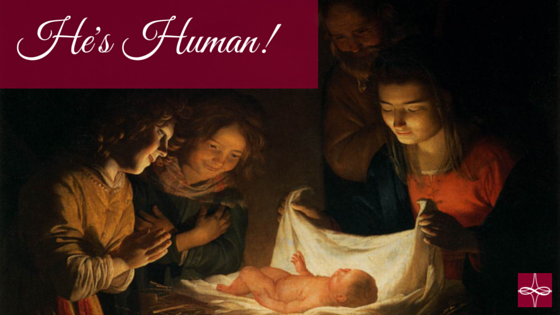

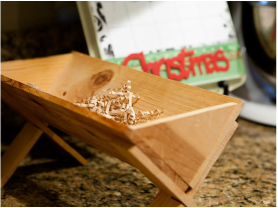
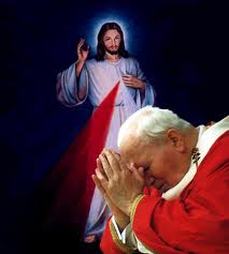
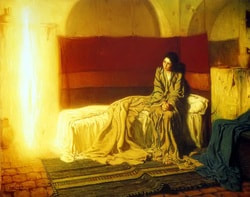
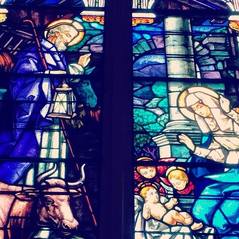
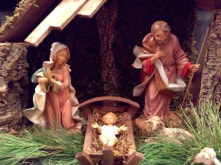
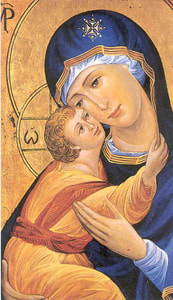
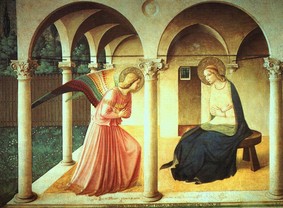
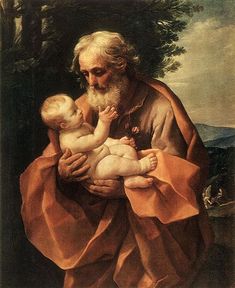
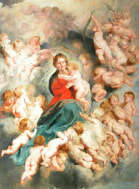
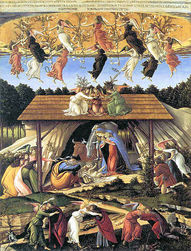
 RSS Feed
RSS Feed